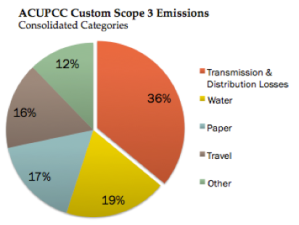By Sarah Brylinsky, Program Associate, Second Nature
(This article appears in the September, 2012 issue of The ACUPCC Implementer)
Scope 3, or indirect emissions not covered by Scope 2, are a challenging set of categories to gather data for in greenhouse gas (GHG) reporting, but are essential for campuses to fully account for their upstream and downstream climate footprint. Greenhouse gas reporting for the ACUPCC requires signatories to submit two categories of Scope 3 emissions: regular daily commuting to and from campus by students, faculty, and staff and air travel paid for by or through the institution. The
ACUPCC encourages signatories to go beyond these requirements and submit additional indirect emissions categories. An analysis of ACUPCC GHG reports demonstrates that many signatories have chosen to report additional scope 3 emission categories. Of the 93% of the signatories that have submitted at least one GHG report, 65% have included information on their solid waste emissions and 20.6% have elected to report custom scope 3 emissions.

ACUPCC signatories had reported these custom Scope 3 sources in publicly submitted greenhouse gas inventories as of August 2012 (Data taken from rs.acupcc.org)
Taking a closer look at the GHG custom scope 3 sources, it becomes clear that institutions report on areas of both common concern and programmatic significance, with sources ranging from standard (paper procurement) to the highly specific (animal husbandry). Over 180 unique scope 3 sources have been reported, but further analysis shows that the majority of these sources fall under four main categories: Travel, Paper, Water, and electricity Transmission & Distribution Losses. An additional 12% of these custom sources can be categorized as “Other” with more specific accounting.
Transmission & distribution losses, or T&D losses, make up the largest reporting category, accounting for 36% of custom scope 3 sources. Essentially, T&D accounts for the energy lost during electricity transmission, which is a known grid inefficiency. According to US Energy Information Administration (EIA) data, national, annual T&D losses average about 7% of the electricity that is transmitted in the United States, making T&D losses a logical first step for those concerned with fully accounting upstream indirect emissions.
The ACUPCC hosted a webinar Expanding Scope 3 Emissions Tracking and Reporting on September 5, 2012 in partnership with Clean-Air Cool Planet, the Greenhouse Gas Protocol, and the New College of Florida. Panelists discussed the possibilities for campuses to expand their Scope 3 emissions sources in order to account for a fuller emissions baseline by using the Greenhouse Gas Protocol’s newly revised Scope 3 Reporting Standard as a framework for submitting additional custom scope 3 sources, such as T&D, which is considered an “upstream activity” or “investments,” from the college’s endowment, as a “downstream” activity.
The GHG Protocol has just ended a public comment period (July 2012) on an amendment that revises the Corporate, Scope 3 and Product Life Cycle Standards to require the reporting of all UNFCCC GHGs and the use of a more consistent set of Global Warming Potentials (GWP). The update does not affect ACUPCC Scope 3 required reporting, but signatories that are looking at their supply chain emissions should read up on the amendment.
For many of the custom sources reported outside of the ACUPCC requirements for scope 3, there is some question as to whether categories are being double-counted, or belong in a different component of the report. (For those unfamiliar with the requirements of the ACUPCC reports, the Instructions for Submitting a Greenhouse Gas Report may be useful). Additionally, some campuses may be choosing to segment scope 3 or other emissions categories for their own projects or accounting purposes, causing some inconsistencies in reporting. For instance, Biogenic sources created by the combustion of biomass and biomass-based fuels may already accounted for as a Scope 1 source (stationary and/or mobile combustion) in the GHG report, and Study Abroad Air Travel is already included under Scope 3 Air Travel accounting.

Click for an expanded version of the custom scope 3 sources, by category, in ACUPCC public greenhouse gas reports
Categories involving emissions related to water (potable, waste, thermal), food procurement, and investment are of particular interest to campuses and student groups, but with few examples of successful and long-term accounting are currently present to act as leadership models.
For instance, a new study by the Investor Responsibility Research Center Institute (IRRCI) and Tellus Institute, “Environmental, Social and Governance Investing by College and University Endowments in the United States: Social Responsibility, Sustainability, and Stakeholder Relations,” found that college and university endowments’ environmental, social and corporate governance (ESG) investments are “less prevalent than often believed, particularly given their history as sustainable investing pioneers dating back to 1970s anti-apartheid campaigns.” Watch a webinar on the report findings here, or read the press release.
In future GHG reports and the development of reporting for higher education, the role of scope 3 emissions may grow to include accounting for some of these areas in a more formal and ongoing manner as new resources and tools become available. The streamlined reporting in Clean Air-Cool Planet’s soon to be released web-based Campus Carbon Calculator will be among these tools: look for a first release in Fall 2012.
Additionally, the GHG Protocol is working on the development of a reporting standard for assessing the impact of downstream endowment emissions, a tool which, when completed, could provide an essential new tool for students and campuses to assess the climate impact of their endowments.

